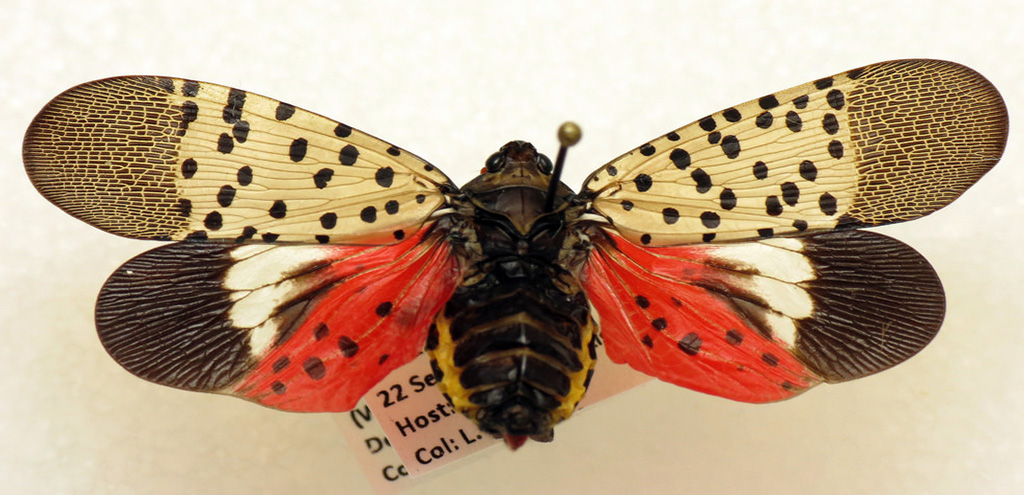THE LEAFLET

What’s black, white, and red all over? Depending on the life stage, Spotted Lanternfly
This article is the third in a series of featured stories this spring/summer with our partners at Bartlett Tree Research Laboratories. This partner series aims to educate the DC region about its insect inhabitants and provide practical tree care advice to residents.
In one of my previous posts, I mentioned that the DC metro area would be spared from the great periodical cicada emergence that is happening across large swaths of the country as we speak. If you were worried about getting your fill of large, colorful, and undoubtedly disruptive bugs, worry not, for I have two words for you: spotted lanternfly. One of the newest invasive insects to appear in DC, spotted lanternfly (SLF) is not actually a fly but rather a planthopper (a not-so-distant relative of cicadas) that was first discovered outbreaking in the suburbs of Philadelphia in 2014. Since those initial detections around a decade ago, SLF has spread rapidly with infestations documented in over 15 states as well as the District of Columbia.
Within the past month, egg masses that were deposited by adult females last fall on trees and other structures began to hatch around the region. The term ‘nymph’ refers to the immature life stage of planthoppers and many, if not all species, progress through multiple nymphal stages, known as ‘instars’. Early SLF instars are black with white spots and crawl and jump as they search for succulent growth to feed on with their straw-like mouthpart (Photo 1). These stages can be seen through about mid-July. Towards the end of the summer, SLF nymphs reach their final instar stage where they take on a brilliant red color with black and white accents (Photo 2). None of these immature stages are capable of flight, but if you look closely at the last instar stage, you can make out the developing wing pads that will become fully fledged wings in adulthood.
- Photo 1: Recently hatched SLF nymphs and the egg mass they emerged from.
- Photo 2: Early (black and white) and late (red) instar nymphs feeding on tree of heaven, Ailanthus altissima.

Photo 4: Adult SLF with forewings and hindwings opened for flight, exposing the striped abdomen below.
By the time Labor Day has arrived, it is not uncommon to begin to see the adults make their presence known (Photo 3). From tip of the head to the end of the wings, adults can be around an inch in length and can crawl, jump, and fly. When resting, feeding, or crawling, their forewings are closed and all that is visible are the spots and stripes that still make for a unique and readily identifiable insect in the landscape. However, when they are ready for flight, they unfurl their forewings and expose their bright red hindwings which are what many people see in photos of this insect and can further aid in identification (Photo 4). Adults persist in the landscape until the first hard freeze, feeding and mating, and leave behind a discrete egg mass that will remain over the winter until the following spring where the life cycle is repeated (Photos 5 and 6).
As far as invasive insects go, I would not consider SLF to be one of the more destructive critters that a member of the public might have to deal with. Much like with the brown marmorated stink bug, large aggregations in your yard or neighborhood can be a nuisance, but the good news is that the threat they pose to the health of most trees and shrubs in the landscape is not extreme. They can, however, be an extreme nuisance. As SLF feed on plant sap, they secrete a sugary, watery byproduct (similar to crapemyrtle bark scale) called ‘honeydew’ that can cause several issues. Honeydew can make structures (e.g., patios, walkways) sticky, it supports the growth and development of black sooty mold, and it can attract stinging insects like wasps that view it as a valuable, carbohydrate-rich resource. While many insect species show a strong host preference at the genus (e.g., Oak or Maple) level, SLF can further cause frustrations with its massive number of documented hosts, meaning some are likely in your landscape. Grape, black walnut, willow, river birch, red maple, and tree of heaven, are a few of the key favorites.
- Photo 5: Most SLF egg masses have a gray protective covering on top of the individual eggs.
- Photo 6: At times, females will fail to deposit the protective covering or only do partially, thereby exposing the individual eggs (finger for scale).
So, what does management look like? Depending on your situation, tolerating their presence as best as possible can be one of the easiest strategies. These bugs, while potentially annoying, pose no obvious, direct threat to human health. There are a multitude of more active management strategies available should you find yourself dealing with large outbreaks or copious honeydew production that have been nicely detailed in this comprehensive management guide provided by Penn State. Whenever considering any form of pest management, make sure to think about your options and approach them through the integrated pest management framework and don’t be afraid to contact a certified arborist for help!




